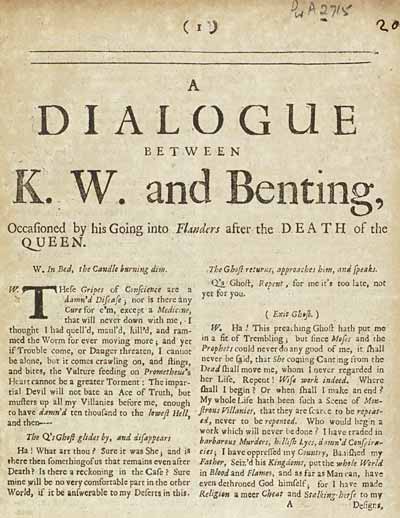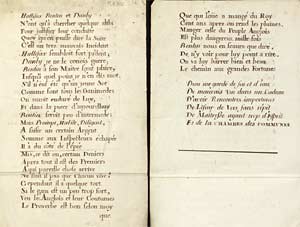Undated Documents
From time to time researchers will come across documents that are not dated at all. In such cases, deciding upon a date becomes a matter of detective work, based on palaeographical and diplomatic features (i.e. the style of the document) or on the contents.
For example: the form of handwriting used in the document may place it before a certain date; a watermark in a paper document may bear date which shows that the item could not have been written any earlier; or, there may be reference to a particular individual (e.g. a bishop) or event (e.g. a battle) which allows a date or date-range to be determined. Items in the list of further reading will provide assistance with this.
In this example, the pamphlet entitled 'A Dialogue between K.W. and Benting' is not dated, but a reasonable estimate can be made by reference to the content. The 'K.W.' in question is King William III and 'Benting' is Hans William Bentinck, 1st Earl of Portland. The strap line indicates that the dialogue was 'occasioned by his Going into Flanders after the Death of the Queen'. It is this event, then, which helps to provide the date. William III's queen, Mary, died in December 1694. As a result, the date of the pamphlet must be around that time, i.e. 1694-1695.

Pamphlet, c.1695-1695 (Pw A 2715)
In the second example, a satirical French verse about Lords Halifax, Bentinck and Danby, the date of the document can be narrowed down by using the titles of the individuals concerned.

Satirical verse, c.1688-1689 (Pw A 2035) with detail below

George Savile became 1st Viscount Halifax, or Lord Halifax, in 1668. The poem, then, must date from after that time.
Thomas Osborne was styled Earl of Danby between 1674 and 1689, before being elevated to the title of Marquess of Carmarthen and ultimately Duke of Leeds. Thus the poem must be from between those dates.
William Bentinck was created 1st Earl of Portland at the coronation of William and Mary in February 1689. Since he is not referred to as 'Lord Portland' in the document, the poem must date from before that time.
Finally, the poem's content indicates that it relates to a period after William III had come to power. With all of this information together, it is possible to estimate that the date of the poem is between December 1688 and February 1689.
Next page: Latin numbers, words and phrases used for dates